Effects of GAHE Application on Annual Changes in Microclimate Parameters in Equine Facilities
Abstract
1. Introduction
1.1. Reasons for Raising the Issue
1.2. The Air Direct-Contact, Gravel, Ground Heat Exchanger (GAHE)
1.3. The Conditions for Keeping Horses
1.4. Required Air Parameters for Horse Stables
1.5. Stress and Temperature–Humidity Comfort Conditions in Horse Stables
- High rectal temperature (103–107 °F or 39.5–41.5 °C);
- Increased heart rate at rest;
- Rapid breathing and flared nostrils at rest;
- Rapid heart rate;
- Dehydration: loss of skin elasticity, tacky gums, sunken eyes, and reduced urine output;
- Exhaustion or lethargy;
- Excess sweating and hot skin;
- Reduced feeding intake;
- Incoordination;
- Heatstroke symptoms such as weakness;
- Stumbling.
1.6. Solution Idea
1.7. Research Gap and the Aims of This Paper
- Determining the practical feasibility of using a GAHE to provide optimal microclimate parameters in a typical stable, considering the facility’s specifics and the environmental requirements for horses;
- Investigating the influence of different types of ventilation systems and assumed air flows on the achieved microclimate parameters in the stable, with particular attention given to inside air temperatures and humidity values obtained by using a GAHE.
1.8. Novelty of This Paper
- Pioneering analysis of the application of thoroughly researched ground-air heat exchangers (GAHEs) in the context of modern stable design. Previous research on GAHEs has focused mainly on residential buildings, office buildings, or certain types of industrial facilities. This paper fills a gap in the literature by presenting a detailed analysis of the possibilities of integrating and operating GAHEs in the specific environment of a modern horse stable, taking into account its unique ventilation and comfort requirements.
- A comprehensive approach to improving the microclimate in horse stables using GAHEs. The paper is not limited to a general description of the system, but thoroughly analyses how a GAHE can actively influence indoor air temperature and humidity, contributing to optimising the conditions for animals. This represents a significant expansion of current knowledge with respect to the applications of this technology. Furthermore, the research highlights the viability of a simple, low-cost GAHE system constructed from readily available materials and harnessing renewable geothermal energy to achieve indoor air parameters comparable to those of conventional HVAC systems, which are not only capital-intensive but also energy-demanding in operation. This sustainable alternative presents a cost-effective, environmentally friendly solution for optimising horse stable environments without compromising performance or animal health.
- A detailed comparison of the performance of the proposed solution with traditional ventilation systems that do not utilise a ground-air heat exchanger. This analysis covers not only technical and energy parameters but also potential benefits for horse welfare and the indoor environment, providing empirical evidence for the advantages of GAHEs under specific conditions.
- Development of a proposal for an innovative ventilation control system for horse stables, considering the specific operation of the GAHE. The presented control system concept aims to maximise the energy efficiency of the GAHE and optimally adapt microclimate parameters to changing external conditions and animal needs, thus providing a practical contribution to the development of intelligent ventilation systems in the construction of livestock buildings.
- Highlighting the benefits of using GAHEs in the fight for horse health by delivering filtered, cleaner, fresher, and more thermally stable air to horse stables. The resulting improvement in the microclimate can directly translate into a reduced risk of respiratory diseases and an overall improvement in animal welfare.
2. Materials and Methods
2.1. Analysis
2.2. Assumptions
2.2.1. Basic Building Parameters
2.2.2. Building Internal Conditions—Internal Heat Gain Calculation Method
2.2.3. Building Internal Conditions—GAHE Simulation Data
2.3. Options Considered and Research Routes
Considered Variants of Ventilation Schemes
- Variant 0 Outside—the horses are kept outside in external conditions, second Polish climate zone.
- Variant 1 no GAHE, 4.0 ach—ventilation air volume set to a minimum acceptable value at 2650 m3/h (exchange rate 4.0 ach), no GAHE used.
- Variant 2 GAHE, 4.0 ach—ventilation air volume set at a minimum acceptable value at 2650 m3/h (exchange rate 4.0 ach), GAHE supported ventilation.
- Variant 3 no GAHE, 8.0 ach—ventilation air volume set to a maximum acceptable value at 5300 m3/h (exchange rate 8.0 ach), no GAHE used.
- Variant 4 GAHE, 8.0 ach—ventilation air volume set to a maximum acceptable value at 5300 m3/h (exchange rate 8.0 ach), ventilation supported with GAHE.
- Variant 5 MIX—ventilation air volume and GAHE usage controlled based on outside air temperature and time of day, details presented in Table 7.
3. Results
3.1. Results of Calculations and Analyses
3.1.1. Current Standard—Mechanically Ventilated Stable
- Too-low air temperatures, values below 8.0 °C, occurred for 4332 h (49.5% of the year);
- Too-high air temperatures, values above 20.0 °C, occurred for 699 h (8.0% of the year);
- Too-high relative air humidity, values above 70.0%, occurred for 6523 h (74.5% of the year);
- The maximum daily fluctuation in air temperature was 19.0 °C.
- Too-low air temperatures, values below 8.0 °C, occurred for 684 h (7.8% of the year), a reduction of 3648 h;
- Too-high air temperatures, values above 20.0 °C, occurred for 1451 h (16.6% of the year), an increase of 752 h;
- Too-high relative air humidity, values above 70.0%, occurred for 2763 h (31.5% of the year), a reduction of 3760 h;
- The maximum daily fluctuation in air temperature was 9.2° C, a reduction of 9.8 °C.
3.1.2. Basic Application of GAHE
- There were no air temperature values below 8.0 °C, a reduction of 684 h;
- Too-high air temperatures, values above 20.0 °C, occurred for 157 h (1.8% of the year), a reduction of 1294 h;
- Too-high relative air humidity, values above 70.0%, occurred for 3123 h (35.7% of the year), an increase of 360 h;
- The maximum daily fluctuation in air temperature was 3.6 °C, a reduction of 5.6 °C.
3.1.3. Further Modifications to the Solution
- Air humidity by using a larger external air flow (Variant 3);
- Air humidity by using a larger GAHE air flow (Variant 4);
- The maximum air temperature by increasing the GAHE air flow (Variant 4).
- Too-low air temperatures, values below 8.0 °C, occurred for 2338 h (26.7% of the year), 2338 h more than in Variant 2;
- Too-high air temperatures, values above 20.0 °C, occurred for 993 h (11.3% of the year), 836 h more than in Variant 2;
- Too-high relative air humidity, values above 70.0%, occurred for 3467 h (39.6% of the year), 344 h more than in Variant 2;
- The maximum daily fluctuation in air temperature was 12.3 °C, 8.7 °C more than in Variant 2.
- Too-low air temperatures, values below 8.0 °C, occurred for 530 h (6.1% of the year), 530 h more than in Variant 2;
- Too-high air temperatures, values above 20.0 °C, occurred for 31 h (0.4% of the year), 126 h less than in Variant 2;
- Too-high relative air humidity, values above 70.0%, occurred for 3286 h (37.5% of the year), 163 h more than in Variant 2;
- The maximum daily fluctuation in air temperature was 4.1 °C, 0.5 °C more than in Variant 2.
3.1.4. Final Variant for the Adopted Assumptions
- There were no air temperature values below 8.0 °C, the same as in Variant 2;
- Too-high air temperatures, values above 20.0 °C, occurred for 29 h (0.3% of the year), 128 h less than in Variant 2;
- Too-high relative air humidity, values above 70.0%, occurred for 3314 h (37.8% of the year), 191 h more than in Variant 2;
- The maximum daily fluctuation in air temperature was 4.4 °C, 0.8 °C more than in Variant 2.
3.2. Comparison of Variants
4. Discussion
5. Conclusions
6. Limitations and Future Research
Author Contributions
Funding
Data Availability Statement
Conflicts of Interest
References
- Harewood, E.J.; McGowan, C.M. Behavioral and physiological responses to stabling in naive horses. J. Equine Vet. Sci. 2005, 25, 164–170. [Google Scholar] [CrossRef]
- Janczarek, I.; Wilk, I.; Wiśniewska, A.; Kusy, R.; Cikacz, K.; Frątczak, M.; Wójcik, P. Effect of air temperature and humidity in stable on basic physiological parameters in horses. Roczniki Nauk. Pol. Tow. Zoot. 2020, 16, 55–65. [Google Scholar] [CrossRef]
- Goodwin, D. Horse behaviour: Evolution, domestication and feralization. In The Welfare of Horses; Springer: Dordrecht, The Netherlands, 2007. [Google Scholar]
- Mills, D.S.; Clarke, A. Housing, management and welfare. In The Welfare of Horses; Springer: Dordrecht, The Netherlands, 2007. [Google Scholar]
- Minero, M.; Canali, E. Welfare issues of horses: An overview and practical recommendations. Ital. J. Anim. Sci. 2009, 8, 219–230. [Google Scholar] [CrossRef]
- Besler, G.J. Bezprzeponowy Gruntowy Wymiennik Ciepła i Masy. Patent nr. 128261 PRL, 28 June 1985. [Google Scholar]
- Besler, M. Badania Efektywności Wykorzystania Energii Gruntu w Inżynierii Środowiska. Praca Doktorska, Politechniki Wrocławskiej, Wrocław, Poland, 1997. [Google Scholar]
- Cepiński, W. Efektywność Pozyskiwania Energii Naturalnej. Praca Doktorska, Efektywność Pozyskiwania Energii Naturalnej, Wrocław, Poland, 2010. [Google Scholar]
- Elfman, L.; Riihimäki, M.; Pringle, J.; Wålinder, R. Influence of horse stable environment on human airways. J. Occup. Med. Toxicol. 2009, 4, 10. [Google Scholar] [CrossRef]
- Nardoni, S.; Mancianti, F.; Sgorbini, M.; Taccini, F.; Corazza, M. Identification and seasonal distribution of airborne fungi in three horse stables in Italy. Mycopathologia 2005, 160, 29–34. [Google Scholar] [CrossRef]
- Fritz, C.; Maleh, S. Zivilisationrankheiten des Pferdes—Ganzheitliche Behandlung Chronischer Krankheiten; Sonntag Verlag: Stuttgart, Germany, 2016. [Google Scholar]
- Meyer, H.; Coenen, M.; Vervuert, J. Pferdefütterung; Enke Verlag: Stuttgart, Germany, 2014. [Google Scholar]
- Kwiatkowska-Stenzel, A.; Sowińska, J.; Witkowska, D. The Effect of Different Bedding Materials Used in Stable on Horses Behavior. J. Equine Vet. Sci. 2016, 42, 10–14. [Google Scholar] [CrossRef]
- Janczarek, I.; Wilk, I.; Zalewska, E.; Bocian, K. Correlations between the behavior of recreational horses, the physiological parameters and summer atmospheric conditions. Anim. Sci. J. 2015, 86, 721–728. [Google Scholar] [CrossRef]
- Hodgson, D.R.; Davis, R.E.; McConaghy, F.F. Thermoregulation in the horse in response to exercise. Br. Vet. J. 1994, 150, 219–235. [Google Scholar] [CrossRef]
- Samadi, S.; Wouters, I.M.; Houben, R.; Jamshidifard, A.; Eerdenburg, F.; Heederik, D.J.J. Exposure to inhalable dust, endotoxins, β(1→3)-glucans, and airborne microorganisms in horse stables. Ann. Occup. Hyg. 2009, 53, 595–603. [Google Scholar] [CrossRef]
- Gallagher, L.M.; Crane, J.; Fitzharris, P.; Bates, M.N. Occupational respiratory health of New Zealand horse trainers. Int. Arch. Occup. Environ. Health 2007, 80, 335–341. [Google Scholar] [CrossRef]
- Wålinder, R.; Riihimäki, M.; Bohlin, S.; Hogstedt, C.; Nordquist, T.; Raine, A.; Pringle, J.; Elfman, L. Installation of mechanical ventilation in a horse stable: Effects on air quality and human and equine airways. Environ. Health Prev. Med. 2011, 16, 264–272. [Google Scholar] [CrossRef] [PubMed]
- Elfman, L.; Wålinder, R.; Riihimäki, M.; Pringle, J. Air Quality in Horse Stables. In Chemistry, Emission Control, Radioactive Pollution and Indoor Air Quality; InTech: Houston, TX, USA, 2011. [Google Scholar] [CrossRef]
- Clarke, A.F. A review of environmental and host factors in relation to equine respiratory disease. Equine Vet. J. 1987, 19, 435–441. [Google Scholar] [CrossRef]
- Bullone, M.; Murcia, R.Y.; Lavoie, J.P. Environmental heat and airborne pollen concentration are associated with increased asthma severity in horses. Equine Vet. J. 2016, 48, 479–484. [Google Scholar] [CrossRef] [PubMed]
- Woods, P.S.; Robinson, N.E.; Swanson, M.C.; Reed, C.E.; Broadstone, R.V.; Derksen, F.J. Airborne dust and aeroallergen concentration in a horse stable under two different management systems. Equine Vet. J. 1993, 25, 208–213. [Google Scholar] [CrossRef] [PubMed]
- Pirie, R.S.; Collie, D.D.S.; Dixon, P.M.; McGorum, B.C. Inhaled endotoxin and organic dust particulates have synergistic proinflammatory effects in equine heaves (organic dust-induced asthma). Clin. Exp. Allergy 2003, 33, 676–683. [Google Scholar] [CrossRef]
- Łojek, J. Dobrostan i utrzymanie koni. In Hodowla i Użytkowanie Koni; Wydawnictwo SGGW: Warsaw, Poland, 2013; Volume T. II. [Google Scholar]
- Bombik, T.; Górski, K.; Bombik, E.; Malec, B. Evaluation of selected Parameters of Horse stabling Environment in Box-Stal Stables. Acta Sci. Pol. Zootech. 2009, 8, 17–28. [Google Scholar]
- Kaletowski, K. Budownictwo dla koni—Małe stajnie. Koń Polski 1997, 2. [Google Scholar]
- Jodkowska, E. Wskazania przed rozpoczęciem budowy ośrodka hippicznego. Przegl. Hodowlany 2002, 7. [Google Scholar]
- Fiedorowicz, G.; Łojek, J.; Clausen, E. Budowa nowych stajni i modernizacja budynków inwentarskich dla koni. Przegl. Hodowlany 2004, 12. [Google Scholar]
- Minister Rolnictwa i Rozwoju Wsi. Rozporządzenie Ministra Rolnictwa i Rozwoju Wsi z Dnia 28 Czerwca 2010 r w Sprawie Minimalnych Warunków Utrzymywania Gatunków Zwierząt Gospodarskich Innych Niż te dla Których Normy Ochrony Zostały Określone w Przepisach Unii Europejskiej; Dziennik Ustaw: Warsaw, Poland, 2010; nr 116, poz. 778. [Google Scholar]
- Wolski, L. Mikroklimat W Budynkach Inwentarskich; PWN: Warsaw, Poland, 1988. [Google Scholar]
- McGreevy, P.D.; Cripps, P.J.; French, N.P.; Green, L.E.; Nicol, C.J. Management factors associated with stereotypic and redirected behaviour in the thoroughbred horse. Equine Vet. J. 1995, 27, 86–91. [Google Scholar] [CrossRef]
- Morgan, K. Thermoneutral zone and critical temperatures of horses. J. Therm. Biol. 1998, 23, 59–61. [Google Scholar] [CrossRef]
- Bombik, E.; Bombik, T.; Frankowska, A. Evaluation of selected Parameters of Horse Stabling Environment in Box-Stal Stables. Acta Sci. Pol. Zootech. 2011, 10, 13–22. [Google Scholar]
- Noordhuizen, J.; Noordhuizen, T. Heat Stress in (Sport) Horses: (I) Occurrence, Signs & Diagnosis, (II) Practical Management and Preventive Measures. J. Dairy Vet. Sci. 2017, 2, 555597. [Google Scholar] [CrossRef]
- Polski Związek Hodowców Koni. Sprawozdanie z Działalności Polskiego Związku Hodowców Koni w Latach 2020–2023; Polski Związek Hodowców Koni (PZHK): Warsaw, Poland, 2023. [Google Scholar]
- Fiedorowicz, G. Wymagania dotyczące warunków środowiskowych w chowie koni. Probl. Inż. Roln. 2007, 4, 25–34. [Google Scholar]
- Webster, A.J.F.; Clark, A.F.; Madelin, T.; Wathes, C.M. Air hygiene in stables 1: Effects of stable design, ventilation and management on the concentration of respirable dust. Equine Vet. J. 1987, 19, 448–453. [Google Scholar] [CrossRef]
- Herbut, P.; Nawalany, G.; Angrecka, S.; Janowski, P. Analiza sprawności działania wentylacji grawitacyjnej stajni w okresie zimowym. Infrastrukt. Ekol. Ter. Wiej. 2015, 1, 83–95. [Google Scholar]
- Romaniuk, W.; Overby, T. Systemy Utrzymania Koni. Poradnik; Instytut Budownictwa Mechanizacji i Elektryfikacji Rolnictwa: Warsaw, Poland, 2004. [Google Scholar]
- Kohn, C.W.; Hinchcliff, K.; McKeever, H. Effect of ambient temperature and humidity on pulmonary artery temperature of exercising horses. Equine Vet. J. 1999, 31, 404–411. [Google Scholar] [CrossRef]
- Recknagel, H.; Sprenger, E.; Schramek, E.-R. Heating & Air Conditioning Handbook; R. Oldenbourg Verlag: München, Germany, 2007. [Google Scholar]
- Parker, D.B.; Brown, M.S. Water Consumption for Livestock and Poultry Production; West Texas A&M University: Canyon, TX, USA, 2003. [Google Scholar]
- National Research Council (NRC). Nutrient Requirements of Horses; National Academy Press: Washington, DC, USA, 1989; pp. 30–31. [Google Scholar]
- Fonnesbeck, P.V. Consumption and Excretion of Water by Horses Receiving All Hay and Hay—Grain Diets. J. Anim. Sci. 1968, 27, 1350–1356. [Google Scholar] [CrossRef]
- Mönki, J.; Saastamoinen, M.; Karikoski, N.; Rajamäki, M.; Raekallio, M.; Junnila, J.; Särkijärvi, S.; Norring, M.; Valros, A.; Ben Fatma, S.O.; et al. Effects of Bedding Material on Equine Lower Airway Inflammation: A Crossover Study Comparing Peat and Wood Shavings. Front. Vet. Sci. 2021, 8, 656814. [Google Scholar] [CrossRef]
- Sheats, M.K.; Davis, K.U.; Poole, J.A. Comparative Review of Asthma in Farmers and Horses. Curr. Allergy Asthma Rep. 2022, 22, 65–70. [Google Scholar] [CrossRef]
- Babicz, M.; Kropiwiec-Domańska, K.; Chabuz, W. Wybrane Zagadnienia Produkcji Zwierzęcej T. 5; Wydawnictwo Uniwersytetu Przyrodniczego: Lublin, Poland, 2024. [Google Scholar]
- Kalisek, J.; Kniazkova, I.; Ondr, P.; Soch, M. Evaluation microclimate in the stable national stud farm in Kladruby nad Ladem. Acta Univ. Cibiniensis Ser. E 2013, 17, 43–48. [Google Scholar]
- Müller, H.J.; Brunsch, R. Technical Solutions for Reduction of Heat Stress in Animal Houses. In Proceedings of the Clima 2007 WellBeing Indoors, Helsinki, Finland, 10–14 June 2007; Leibniz-Institute for Agricultural Engineering e.V. (ATB): Potsdam, Germany, 2007. [Google Scholar]
- Klobuszewski, T.; Bombik, T. Czysta stajnia—Zdrowy koń. Koń Polski 1989, 24. [Google Scholar]
- Herbut, E.; Walczak, J. Wpływ środowiska na dobrostan zwierząt. Zesz. Nauk. Przegl. Hod. 2004, 73, 45–56. [Google Scholar]
- Nowicka-Posłuszna, A. Dobrostan koni. Hod. I Jeździec 2004, 1. [Google Scholar]
- Jezierski, T.; Górecka, A. Dobrostan koni sportowych i rekreacyjnych. Hod. I Jeździec 2007, 3. [Google Scholar]
- Barej, W. Środowiska a Zdrowie I Produkcyjność Zwierząt; PWRiL: Warsaw, Poland, 1991. [Google Scholar]
- Olszewski, M.; Kluczyński, W. Przewlekłe schorzenie dolnych dróg oddechowych u koni (COPD). Med. Weter. 1993, 49, 58–61. [Google Scholar]
- Max, A. Zaburzenia oddechowe u nowo narodzonych źrebiąt. Mag. Weter 2003, 12, 27–29. [Google Scholar]
- Mader, T.L.; Davis, M.; Brown-Brandl, T. Environmental factors influencing heat stress in feedlot cattle. J. Anim. Sci. 2006, 84, 3169–3180. [Google Scholar] [CrossRef]
- West, J.W. Effects of heat-stress on production in dairy cattle. J. Dairy Sci. 2003, 86, 2131–2144. [Google Scholar] [CrossRef]
- Nardone, A.; Ronchi, B.; Lacetera, N.; Bernabucci, U. Climatic effects on productive traits in livestock. Vet. Res. Commun. 2006, 30 (Suppl. S1), 75–81. [Google Scholar] [CrossRef]
- Hahn, G.L.; Mader, T.L.; Eingerberger, R.A. Perspective on development of thermal indices for animal studies and management. EAAP Tech. Ser. 2003, 7, 31–44. [Google Scholar]
- Thom, E.C. The discomfort index. Weatherwise 1959, 12, 57–61. [Google Scholar] [CrossRef]
- Sales, G.T.; Fialho, E.T.; Junior, T.Y.F.; Freitas, R.T.F.D.; Day, G.B. Thermal Environment Influence on Swine Reproductive Performance. In Proceedings of the Livestock Environment VIII, Iguassu Falls, Brazil, 31 August–4 September 2008. [Google Scholar]
- Knudsen, C.G. Livestock Hot Weather Stress; U.S. Department of Commerce, National Oceanic and Atmospheric Administration, National Weather Service Central Region: Washington, DC, USA, 1976. [Google Scholar]
- Amstrong, D.V. Heat stress interaction with shade and cooling. J. Dairy Sci. 1994, 77, 2044–2050. [Google Scholar] [CrossRef] [PubMed]
- Wang, X.; Schmidt Bjerg, B.; Choi, C.; Zong, C.; Zhang, G. A review and quantitative assessment of cattle-related thermal indices. J. Therm. Biol. 2018, 77, 77–88. [Google Scholar] [CrossRef] [PubMed]
- Bohmanova, J.; Misztal, I.; Cole, J.B. Temperature-Humidity Indices as Indicators of Milk Production Losses due to Heat Stress. J. Dairy Sci. 2007, 90, 1947–1956. [Google Scholar] [CrossRef]
- NWSCR. Livestock Hot Weather Stress: Regional Operations Manual Letter; National Weather Service Central Region: Kansas City, MO, USA, 1976. [Google Scholar]
- Kowalczyk, W. Model Matematyczny Ciepła I Masy w Bezprzeponowym Gruntowym Wymienniku w Systemie Wentylacyjnym. Praca doktorska, Politechnika Wrocławska, Wydział Inżynierii Środowiska, Wrocław, Poland, 1988. [Google Scholar]
- Official EnergyPlus Website. Weather Data. 2018. Available online: https://energyplus.net/weather-download/europe_wmo_region_6/POL//POL_Wroclaw.124240_IMGW/all (accessed on 1 October 2025).
- Official website of Ministerstwo Inwestycji i Rozwoju. Weather Data. 2025. Available online: https://www.gov.pl/web/archiwum-inwestycje-rozwoj/dane-do-obliczen-energetycznych-budynkow (accessed on 1 October 2025).
- Wienerberger Ceramika Budowlana. Katalog Rozwiązań Ściennych; WCB: Warsaw, Poland, 2024. [Google Scholar]
- Guardian. GlassTime Technical Guide; Guardian Europe S.à r.l.: Bertrange, Luxembourg, 2022. [Google Scholar]
- Pedersen, S.; Sällvik, K. Climatization of Animal Houses Heat and Moisture Production at Animal and House Levels; International Commission of Agricultural Engineering, Section II; Research Centre Bygholm, Danish Institute of Agricultural Sciences: Horsens, Denmark, 2002. [Google Scholar]
- Epstein, Y.; Moran, D. Thermal Comfort and the Heat Stress Indices. Ind. Health 2006, 44, 388–398. [Google Scholar] [CrossRef]
- McNeill, C. Heat Stress in Horses: Signs, Treatment & Prevention. 2023. Available online: https://madbarn.com/heat-stress-in-horses/ (accessed on 1 October 2025).
- Kośla, T.; Porowska, A. The welfare of horses assessed by the investigations of chosen parameters of the stable microclimate. Anim. Sci. 2013, 52, 67–75. [Google Scholar]
- Łuszczyński, J.; Banasiak, M.; Pieszka, M. Comparison of the welfare of Felin Ponies kept in selected Stables during Winter. Roczniki Nauk. Zoot. 2021, 48, 93–107. [Google Scholar]
- Grzyb, J.; Podstawski, Z.; Bulski, K. Bacterial aerosol, particulate matter, and microclimatic parameters in the horse stables in Poland. Environ. Sci. Pollut. Res. 2022, 29, 26992–27006. [Google Scholar] [CrossRef]
- Geor, R.J.; McCutcheon, L.J.; Ecker, G.L.; Lindinger, M.I. Thermal and cardiorespiratory responses of horses to submaximal exercise under hot and humid conditions. Equine Vet. J. 1995, 27, 422–430. [Google Scholar] [CrossRef]
- Marlin, D.J.; Scott, C.M.; Schroter, R.C.; Harris, R.C.; Harris, P.A.; Roberts, C.A.; Mills, P.C. Physiological responses of horses to a treadmill simulated speed and endurance test in high heat and humidity before and after humid heat acclimation. Equine Vet. J. 1999, 31, 404–411. [Google Scholar] [CrossRef]
- Marlin, D.; Nankervis, K. Equine Exercise Physiology; Blackwell Science: Oxford, UK, 2002. [Google Scholar]
- Fédération Equestre Internationale. Veterinary Regulations, 15th ed.; Fédération Equestre Internationale: Lausanne, Switzerland, 2023; Available online: https://inside.fei.org/fei/regulations/veterinary (accessed on 1 October 2025).
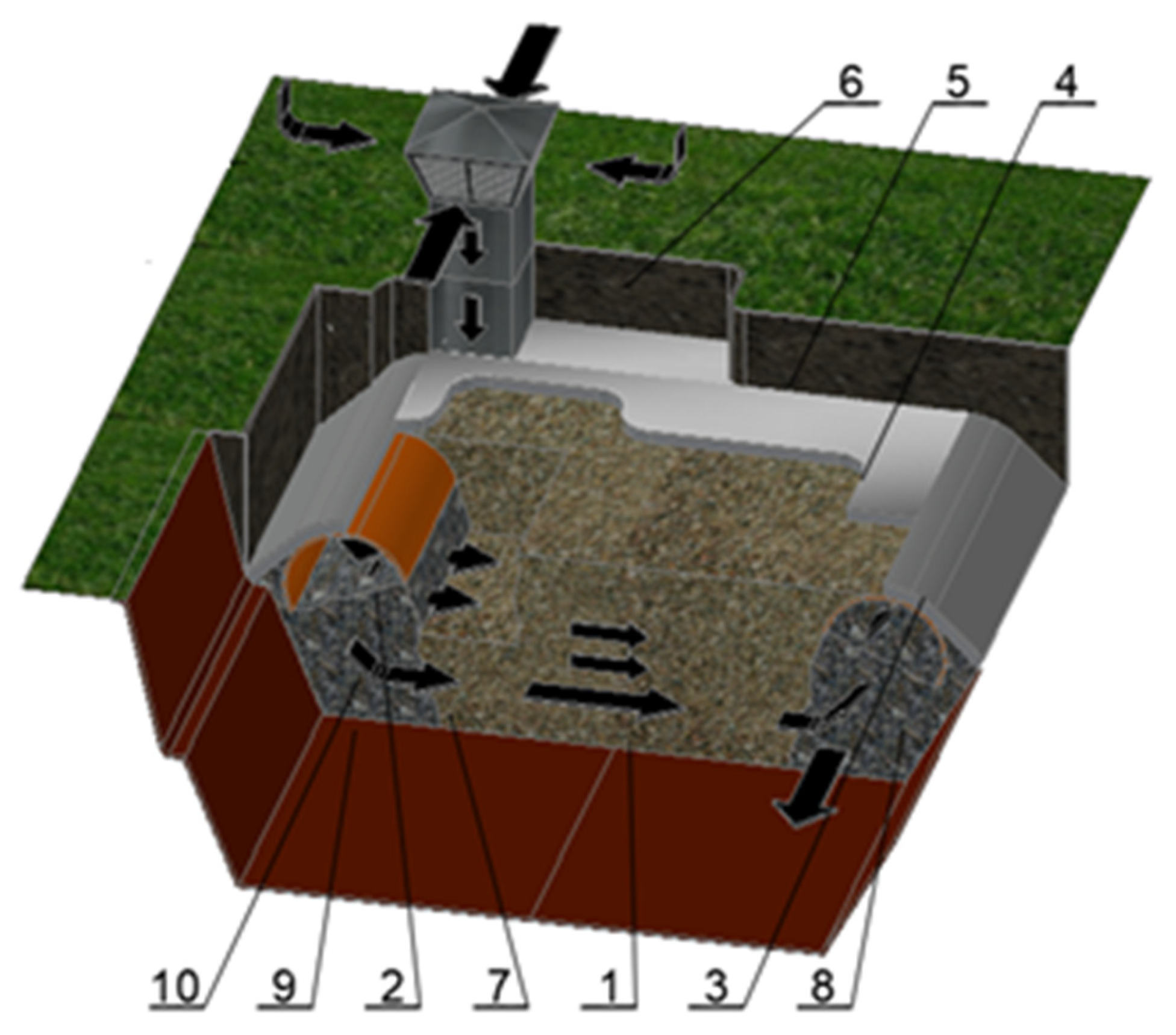

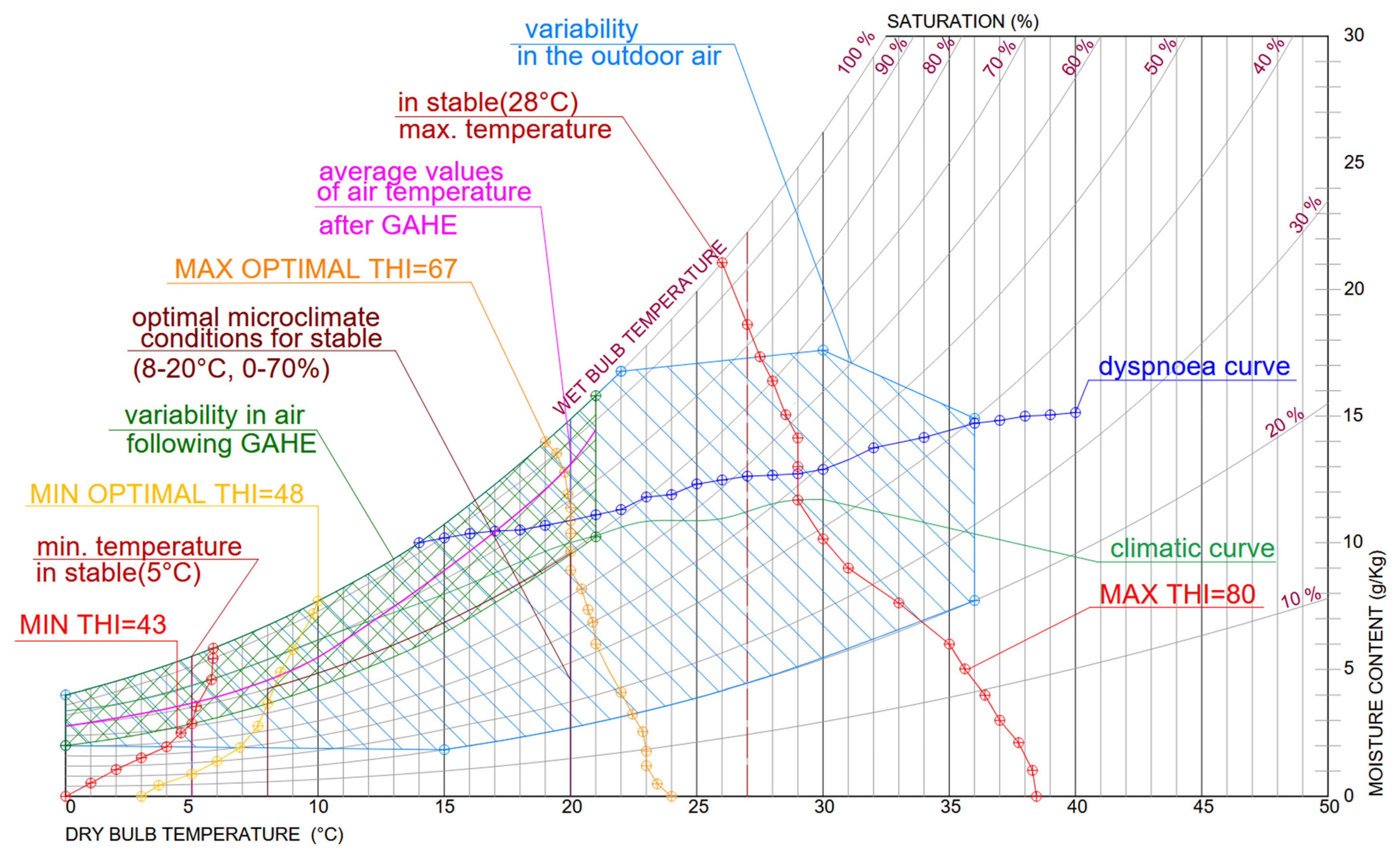
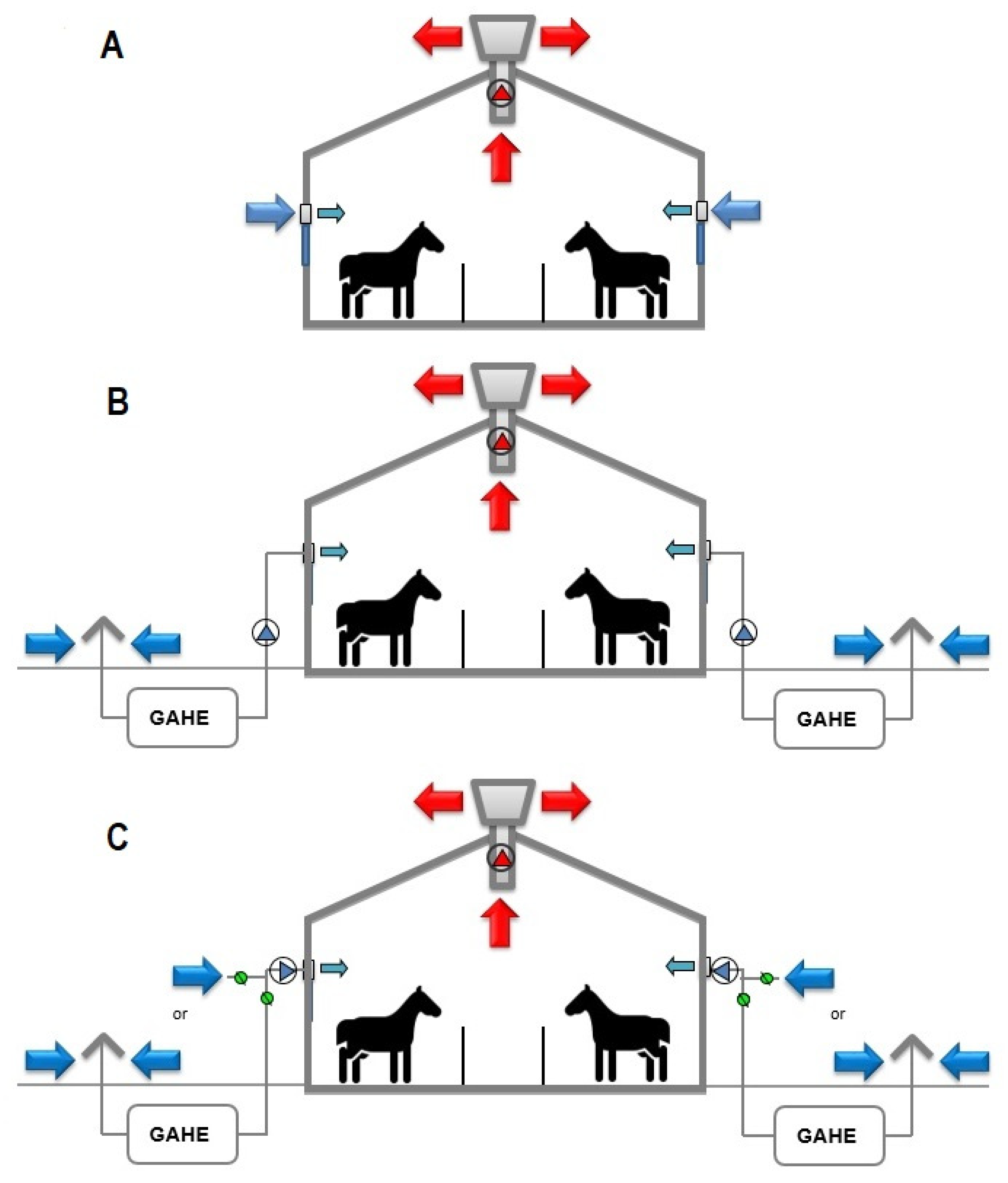

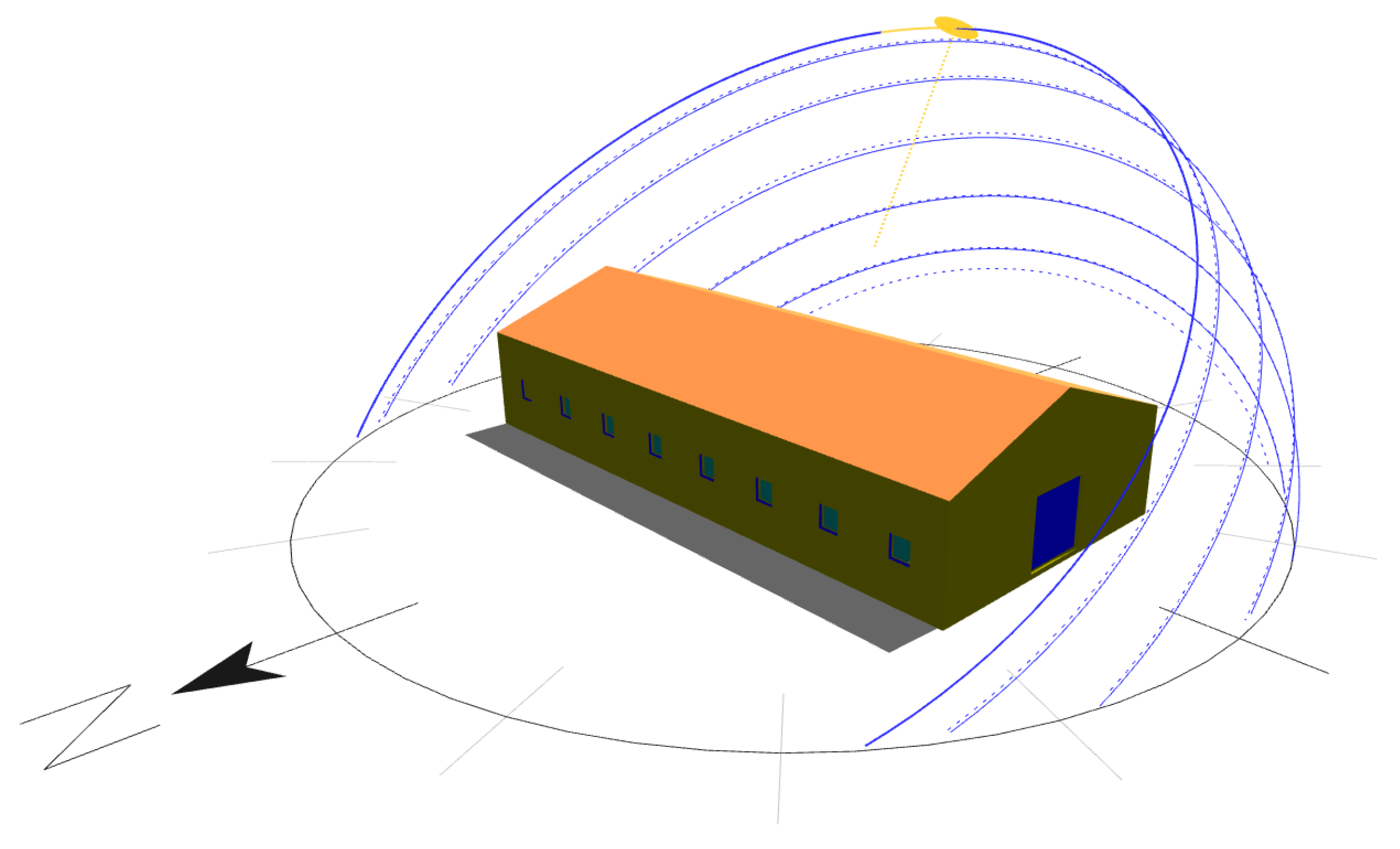


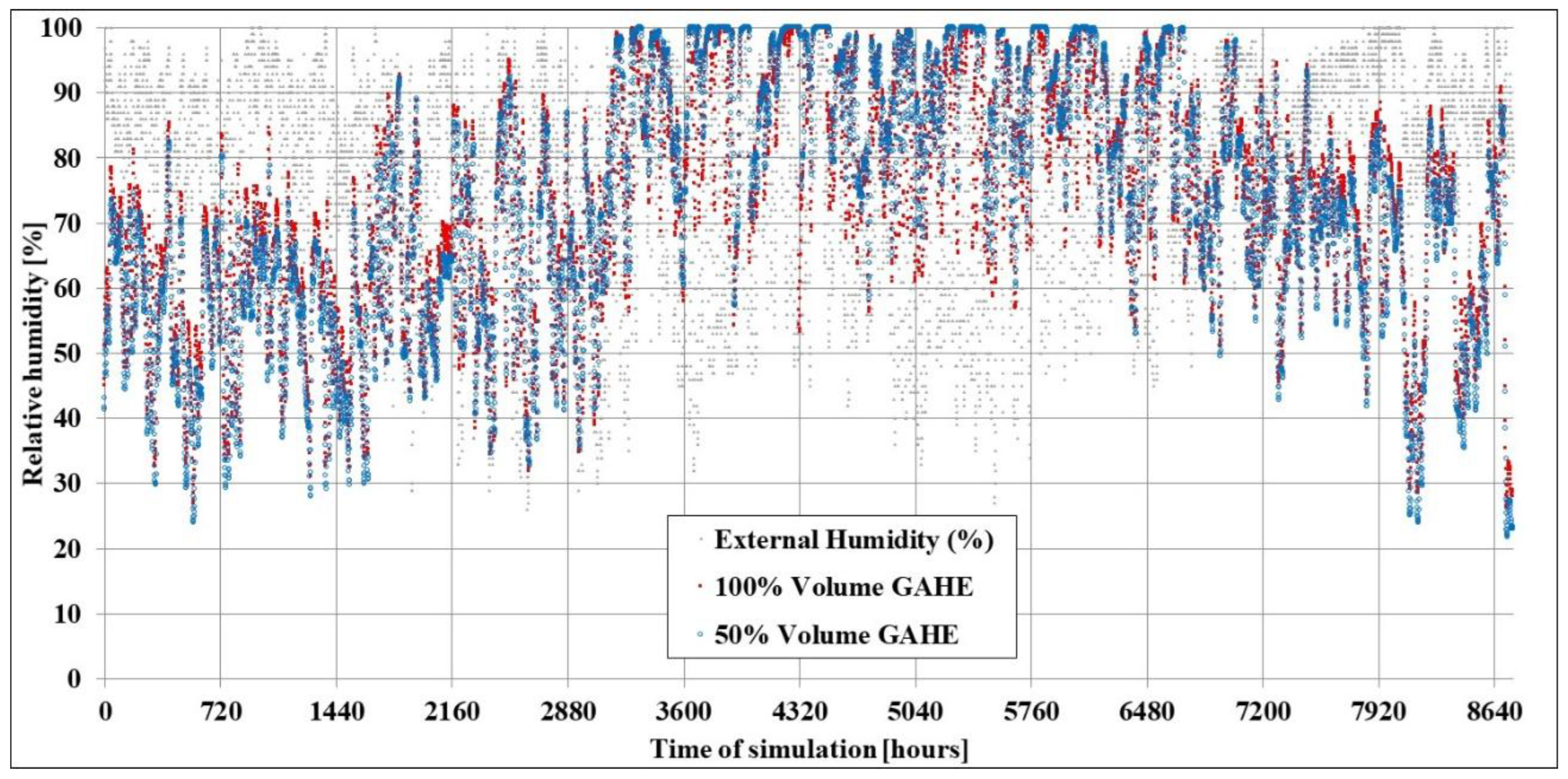
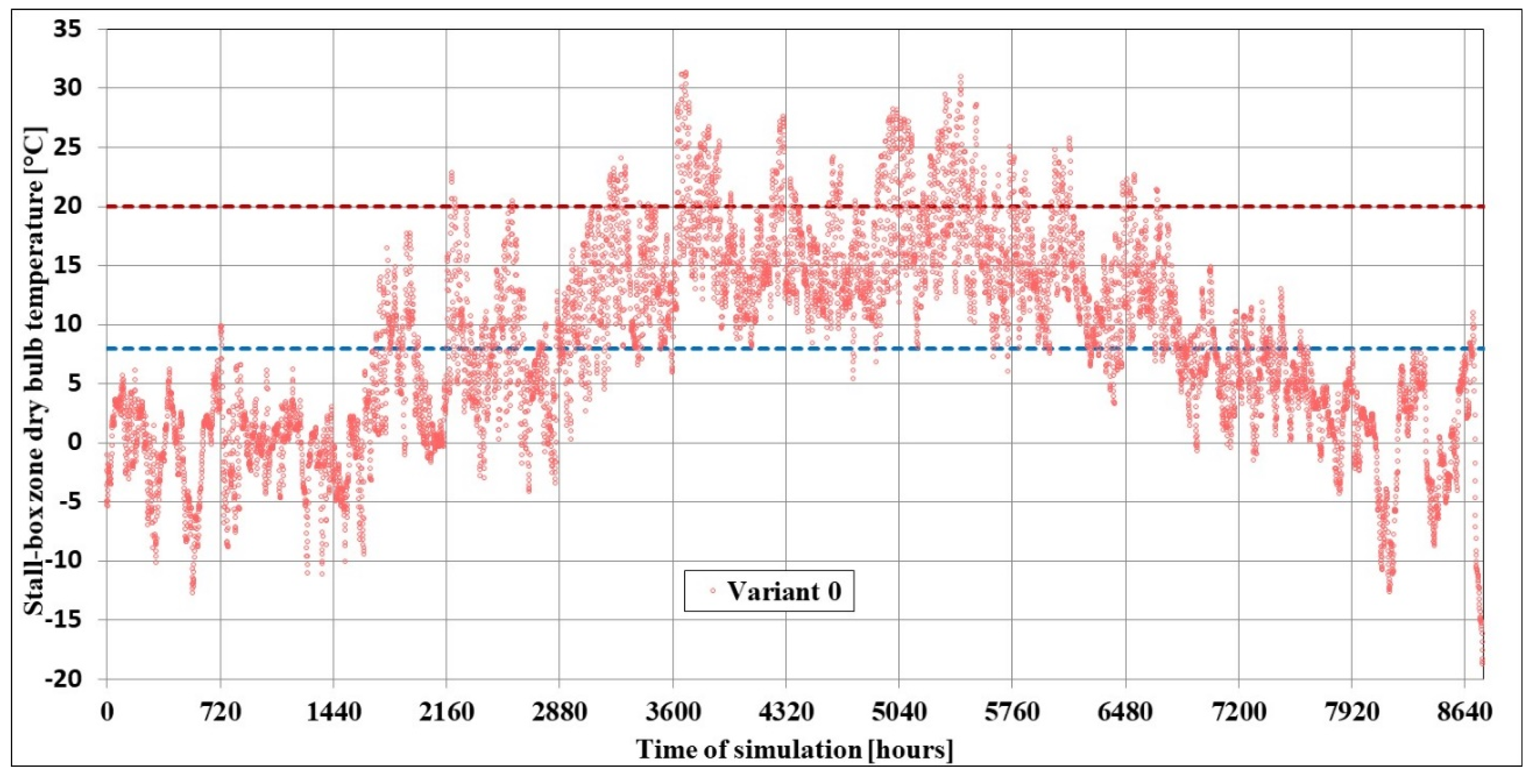
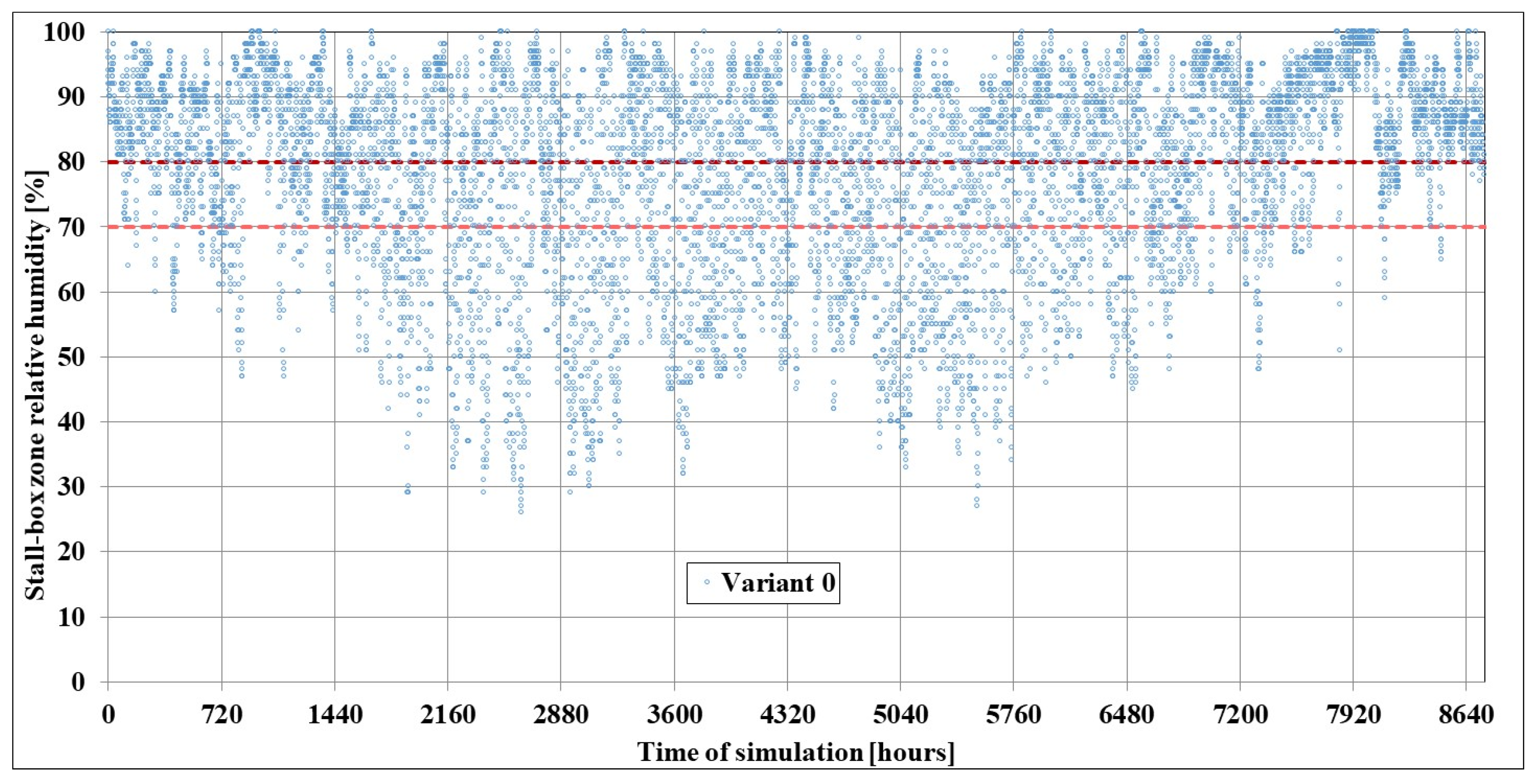

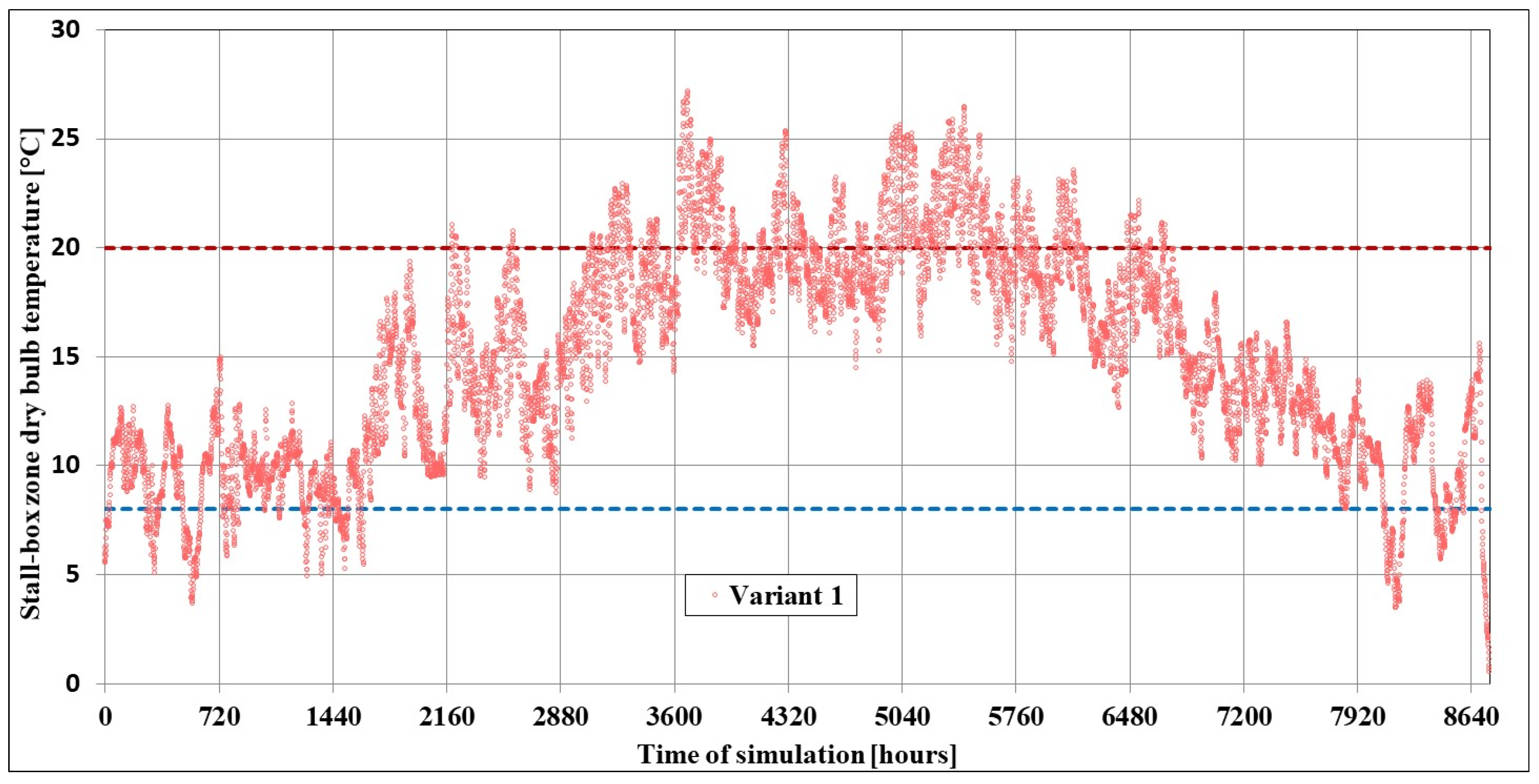

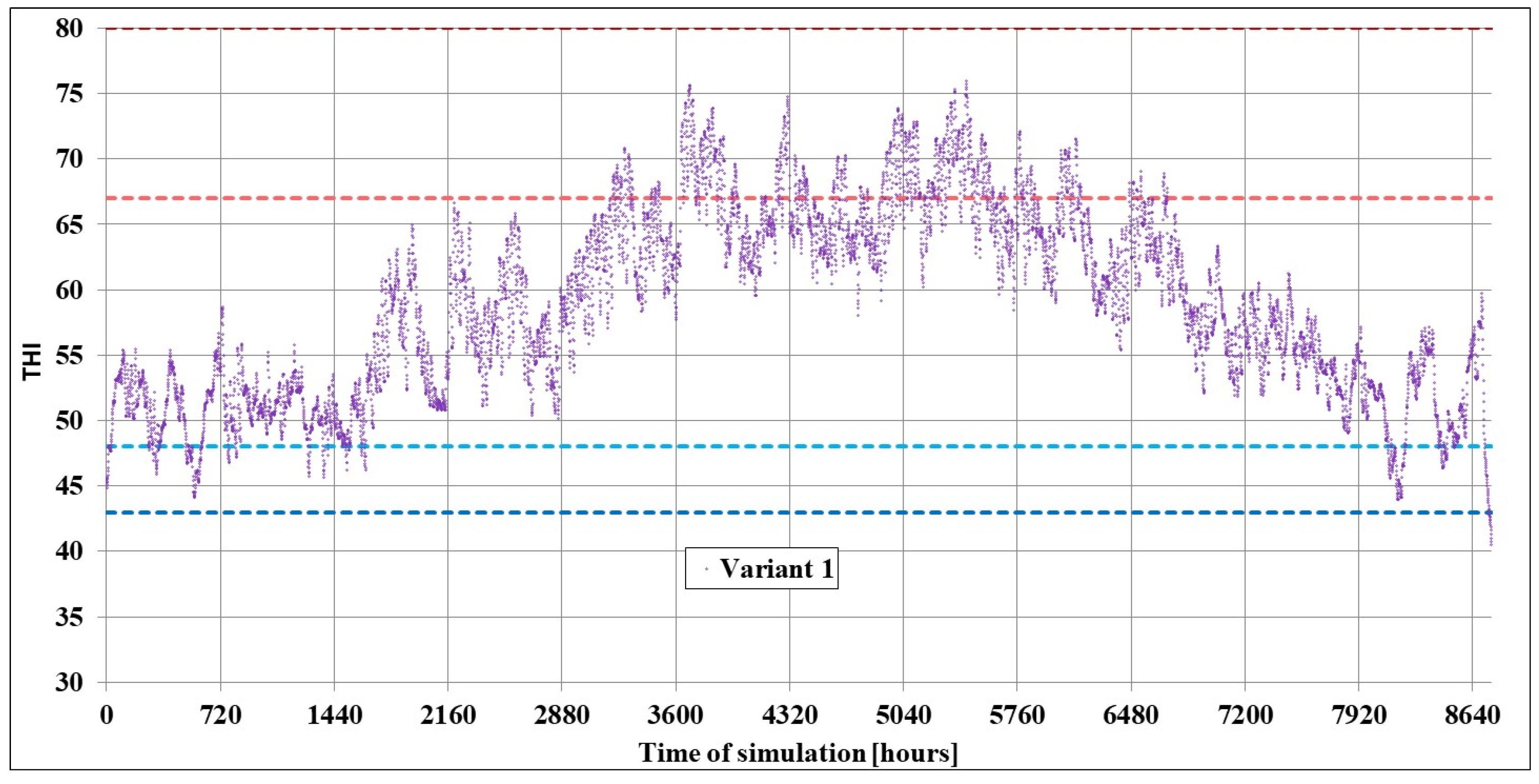
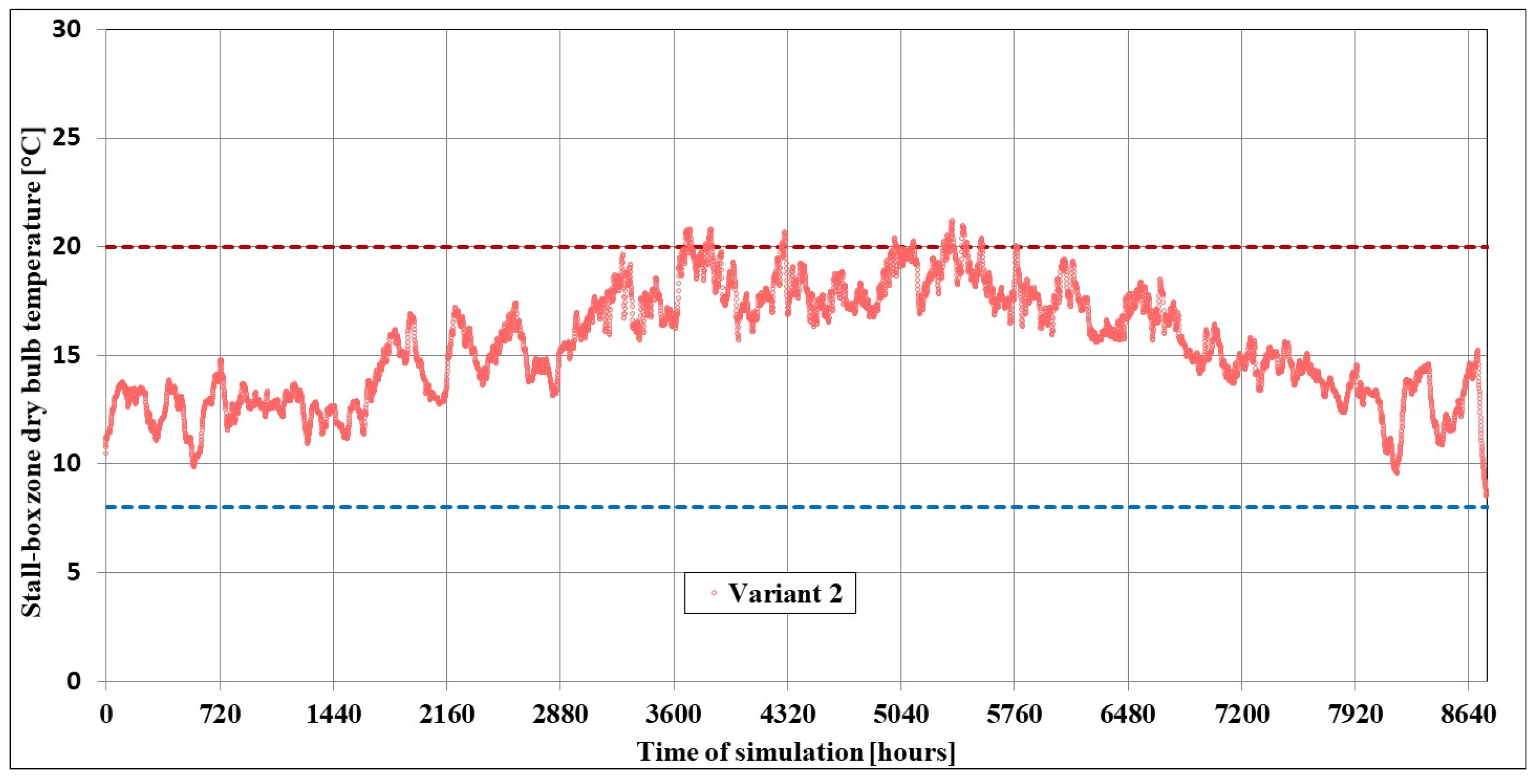
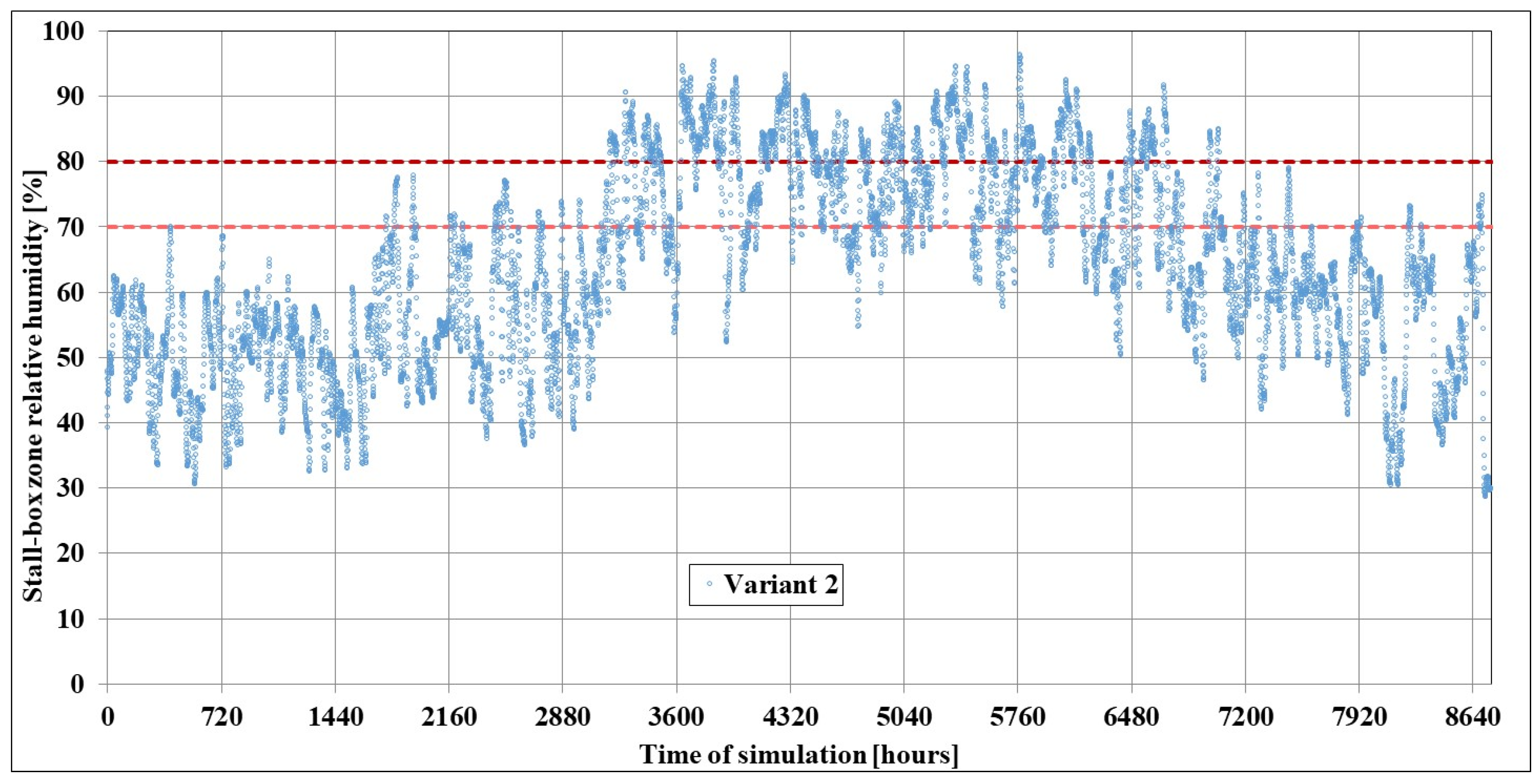
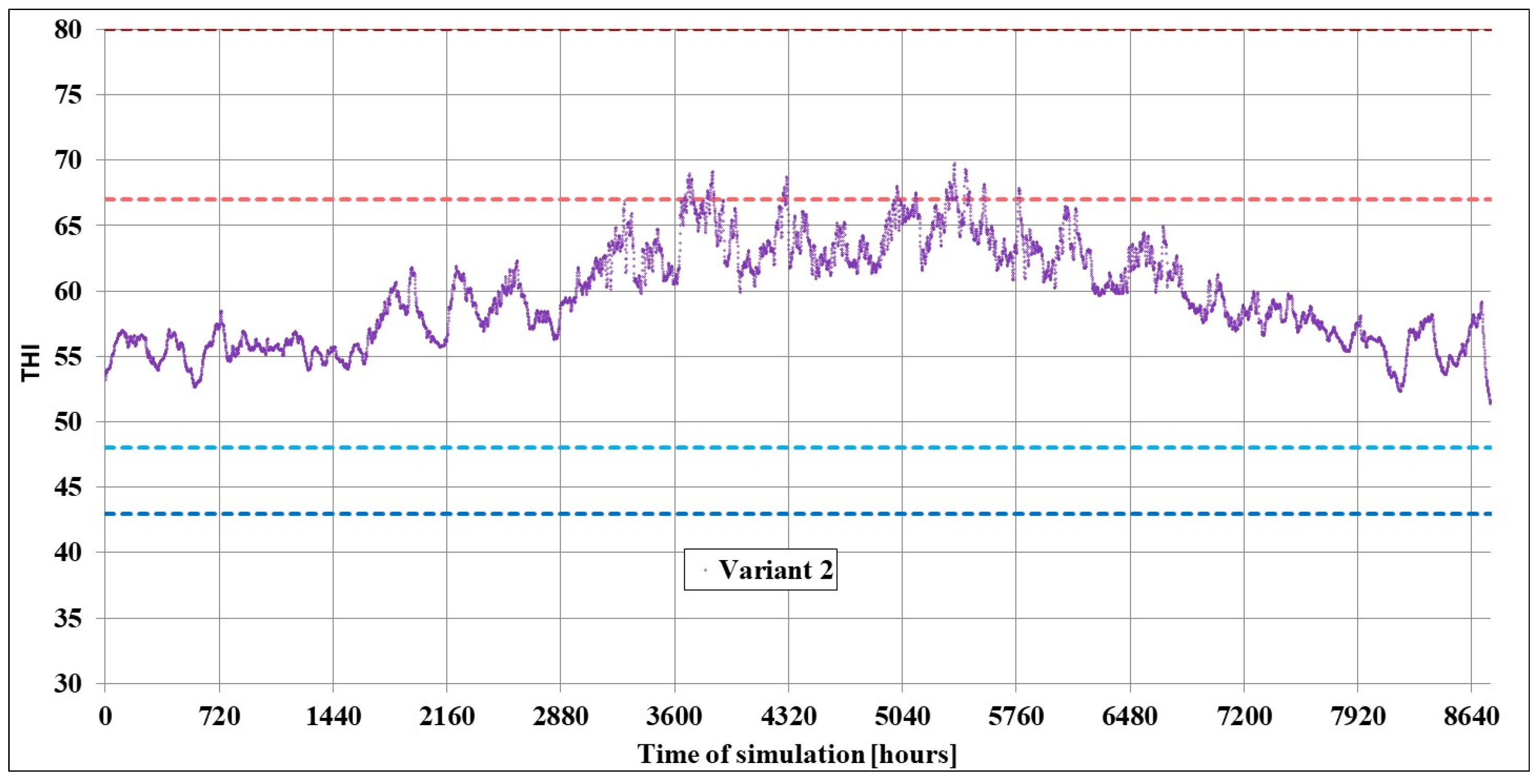

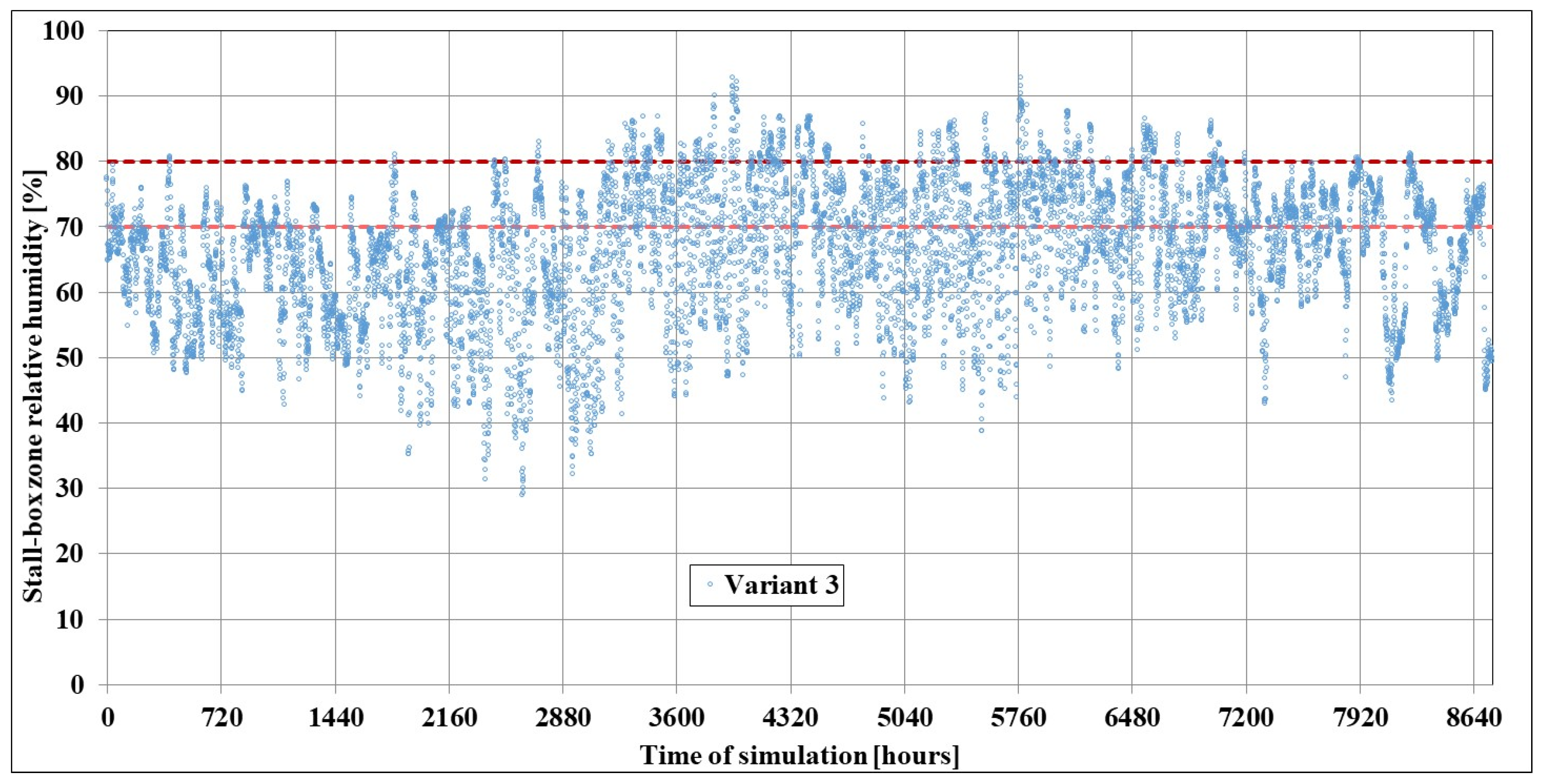

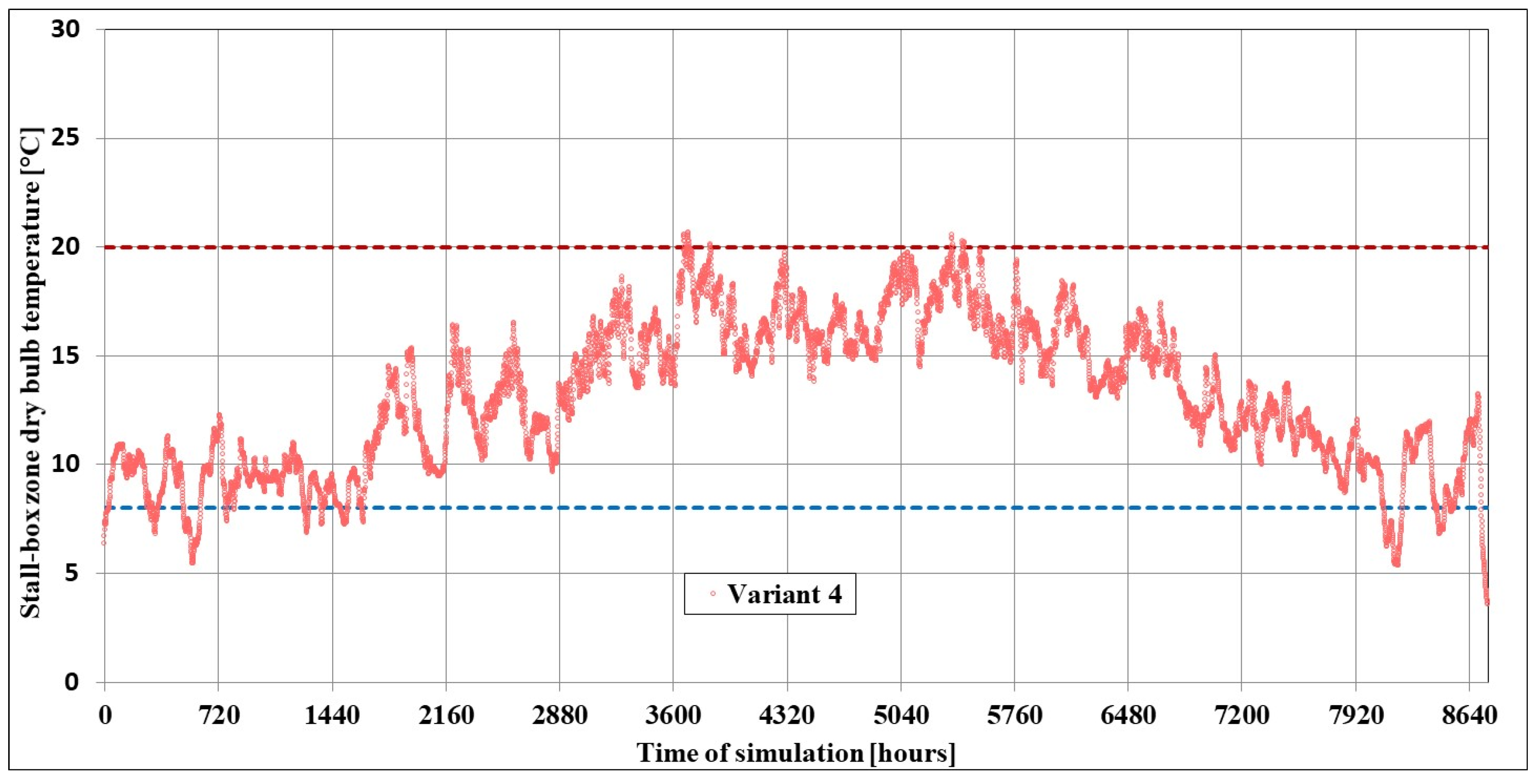

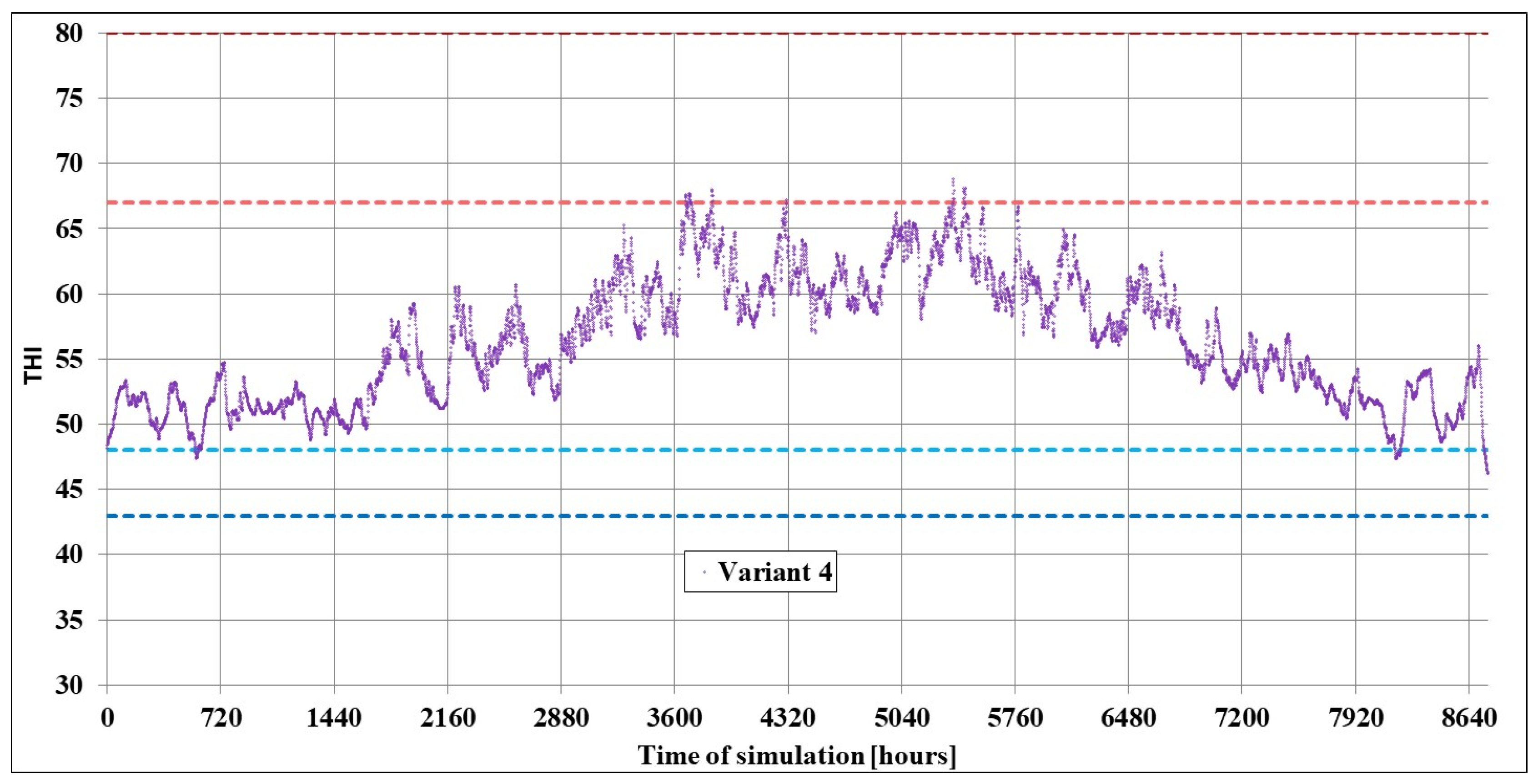
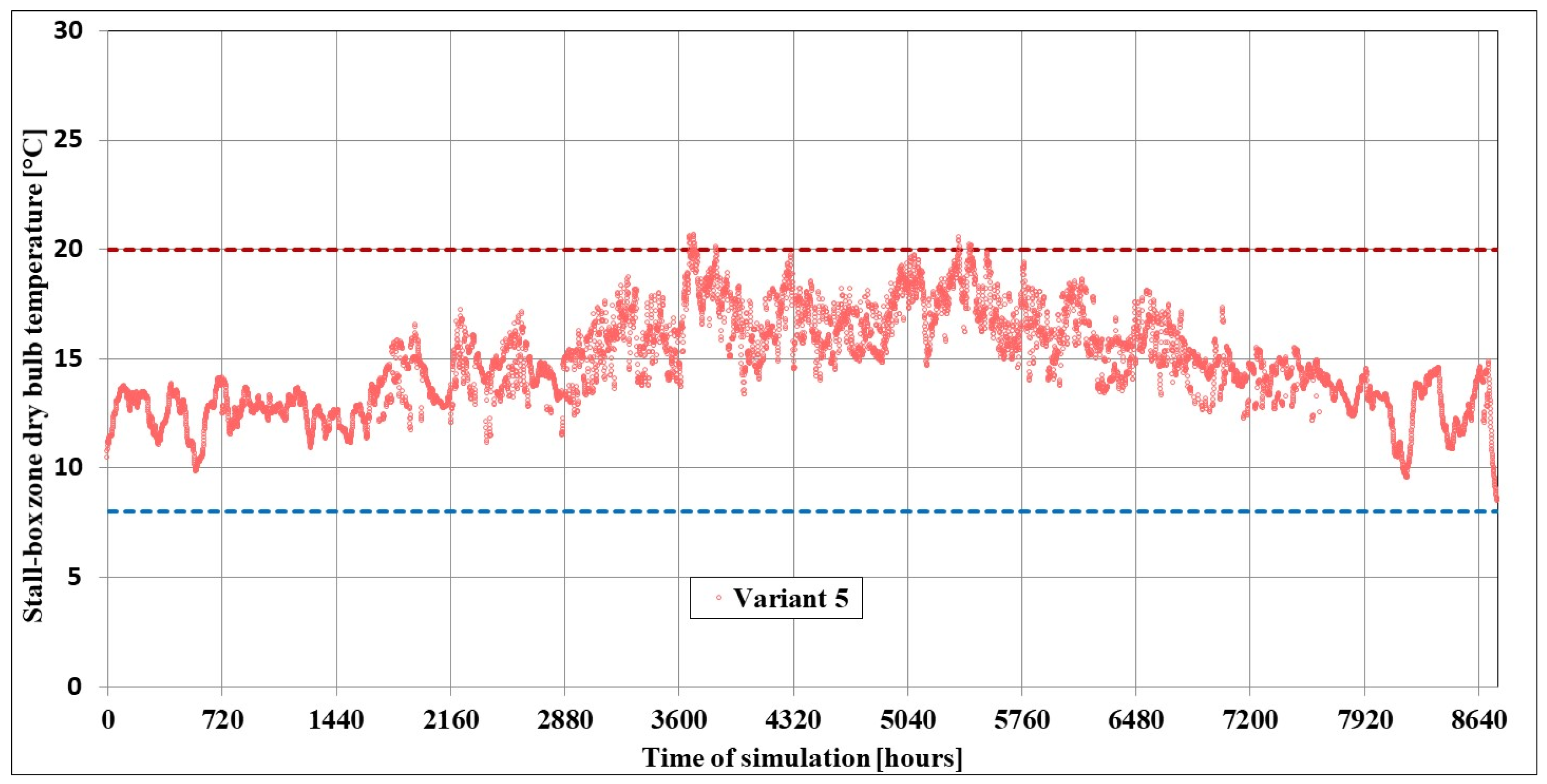




| Meas. Point | Total Number of Bacteria | Number | Total Number of Fungi | |||
|---|---|---|---|---|---|---|
| Actinomycetales | Pseudomonas fluorescens | Staphylococcus | ||||
| Type of Haemolysis | ||||||
| α | β | |||||
| inlet | 10,615 | 3319 | 288 | no incr. | no incr. | 3485 |
| outlet | 680 | 157 | no incr. | no incr. | no incr. | 1231 |
| Parameter | Value/Range |
|---|---|
| Room temperature [2,11,19,35] | Optimal in the winter period 5 (8) °C Optimal in warm period 20 (15) °C |
| Maximum room temperature | 27–28 °C |
| Relative humidity of air [1,2,21,23,35,36] | 80 (70)% |
| Maximum moisture content (dyspnoea curve) | 12 (8.5) g/kg dry air |
| Maximum gas concentration [9,23] (recommended guidelines) | Carbon dioxide (CO2) 3000 ppm Ammonia (NH3) 20 ppm Hydrogen sulfide (H2S) 0.5 ppm |
| Maximum dust level [17] | 3 mg/m3 |
| Maximum noise level [11] | 80 (65) dB |
| Illuminance | min. 100–200 lx light temperature 4000–5000 K |
| Physiological amount of air for one horse (minimum) [11,17] | 40 (30) m3/h |
| Maximum air-flow speed according to Polish regulations [11,29,30] | 1.0 (0.5) m/s |
| Horse body temperature [11] | 37–38 °C can increase during training up to 41 °C |
| Emissions (horse of approximately 500 kg) | CO2 120 dm3/h Steam 83 cm3/s, (300 g/h) Heat 698 W (600 kcal/h) |
| Parameter | Value |
|---|---|
| Calculation time steps per hour | 1 step |
| Simulation period | from 01.01 to 12.31 of typical calc. year |
| Calculation of temperature control | air temperature |
| Calculation of general solution algorithm | conduction transfer function |
| Number of model warm-up days | 45 days |
| Location of the site | Poland/Wroclaw/N 51.10° E 17.03° |
| Weather data [51,52] | WMO Region 6/POL/Station no. 124,240 |
| Terrain type | open |
| Parameter | Value |
|---|---|
| External dim. of the building | 25.36 × 11.96 m |
| Total floor area | 265.45 m2 |
| Total building volume | 1371.81 m3 |
| Stall area | 167.89 m2 |
| Stall hall volume | 661.18 m3 |
| Single-box stall | quantity: 14 stalls, unit dim.: 4.00 × 3.00 m |
| Roof type | Gable, 20° |
| Gates | quantity: 2 gates, total area: 15.68 m2 |
| Wall glazing area | quantity: 16 windows, total area: 16.00 m2 |
| Construction | Manufacturer Type | Total Thickness, mm | U-Value, W/(m2K) |
|---|---|---|---|
| External wall [53] | Wienerberger Porotherm 38 Profi with plaster | 400 | 0.37 |
| Internal partitions | - Hardwood | 80 | 1.32 |
| Gable roof | ALFAPANEL roof panel PU ARGO | 50 | 0.34 |
| Ground floor | - Cast concrete | 200 | 2.27 |
| Glazing [54] | Guardian SunGuard HD Neutral 67 | 7 | 5.40 |
| Frames | - Galvanised steel profile | 60 | 1.48 |
| Parameter | Value |
|---|---|
| Heating and cooling installation | none used |
| Ventilation type | mechanical with or without GAHE |
| Approximate minimum and maximum ventilation air volumes of all stall boxes (exchange rate) | 2650 and 5300 m3/h (4.0 and 8.0 ach) |
| Ventilation air volumes of saddlery, feeding room, bathroom, each | 60 m3/h |
| Roof zone fluorescent lighting heat gains | 4 W/m2 |
| Total horse heat production calculated at 20 °C | 830 W/horse |
| Sensible and latent heat production ratio | depending on the stall-box indoor-air temperature |
| Sensible and latent heat production localisation | stall-box (Box 1) zone only |
| Sensible heat production range MIN/AVERAGE/MAX | 33 W/m2/50 W/m2/60 W/m2 |
| Latent heat production range MIN/AVERAGE/MAX | 15 W/m2/20 W/m2/34 W/m2 |
| External Air Temperature | Time of Day | GAHE Usage | Ventilation Air Volume (Exchange Rate) |
|---|---|---|---|
| te < 8 °C | daylight (4:00 a.m.–7:00 p.m.) night (20:00 p.m.–3:00 a.m.) | on | 2650 m3/h (4.0 ach) |
| te > 15 °C | daylight (4:00 a.m.–7:00 p.m.) night (20:00 p.m.–3:00 a.m.) | on | 5300 m3/h (8.0 ach) |
| 8 °C ≤ te ≤ 15 °C | daylight (4:00 a.m.–7:00 p.m.) | on | 5300 m3/h (8.0 ach) |
| 8 °C ≤ te ≤ 15 °C | night (20:00 p.m.–3:00 a.m.) | off | 2650 m3/h (4.0 ach) |
| Variant | Temperature [°C] | Relative Humidity [%] | Both | |||||||
|---|---|---|---|---|---|---|---|---|---|---|
| t < 8 °C | t > 15 °C | t > 20 °C | t < 5 °C | t > 27 °C | φ > 70% | φ > 80% | φ > 90% | 8 > t > 20 and φ > 70% | 5 > t > 27 and φ > 80% | |
| 0 | 4332 | 1955 | 699 | 3380 | 72 | 6523 | 4957 | 2332 | 7587 | 5814 |
| 1 | 684 | 4315 | 1451 | 97 | 3 | 2763 | 490 | 19 | 4219 | 590 |
| 2 | 0 | 4737 | 157 | 0 | 1 | 3123 | 1713 | 157 | 3124 | 1714 |
| 3 | 2338 | 3324 | 993 | 855 | 15 | 3467 | 590 | 11 | 6150 | 1460 |
| 4 | 530 | 3023 | 31 | 17 | 1 | 3286 | 1708 | 310 | 3816 | 1726 |
| 5 | 0 | 3678 | 29 | 0 | 1 | 3314 | 1680 | 309 | 3315 | 1681 |
| Variant | THI | ||||
|---|---|---|---|---|---|
| THI < 43 | THI < 48.6 | THI > 67.2 | THI > 80 | THI > 85 | |
| 0 | 3489 | 4552 | 557 | 0 | 0 |
| 1 | 15 | 532 | 1205 | 0 | 0 |
| 2 | 0 | 0 | 200 | 0 | 0 |
| 3 | 521 | 2399 | 799 | 0 | 0 |
| 4 | 0 | 128 | 35 | 0 | 0 |
| 5 | 0 | 0 | 36 | 0 | 0 |
| Variant | Δt max | Δt av | THI av | x max | x min | Δx max | Δx av | x av |
|---|---|---|---|---|---|---|---|---|
| °C | °C | g/kg s.p. | g/kg s.p. | g/kg s.p. | g/kg s.p. | g/kg s.p. | ||
| 0 | 19.0 | 6.0 | 47.3 | 14.2 | 0.7 | 19.0 | 5.7 | 5.7 |
| 1 | 8.3 | 3.5 | 58.8 | 16.4 | 1.7 | 8.3 | 7.3 | 7.3 |
| 2 | 3.6 | 0.9 | 59.8 | 14.9 | 2.0 | 3.6 | 7.3 | 7.3 |
| 3 | 11.2 | 4.7 | 55.3 | 15.3 | 1.3 | 11.2 | 6.4 | 6.4 |
| 4 | 5.3 | 1.4 | 56.4 | 14.5 | 1.3 | 5.3 | 6.4 | 6.4 |
| 5 | 4.2 | 1.8 | 58.7 | 14.5 | 2.0 | 4.2 | 6.9 | 6.9 |
Disclaimer/Publisher’s Note: The statements, opinions and data contained in all publications are solely those of the individual author(s) and contributor(s) and not of MDPI and/or the editor(s). MDPI and/or the editor(s) disclaim responsibility for any injury to people or property resulting from any ideas, methods, instructions or products referred to in the content. |
© 2025 by the authors. Licensee MDPI, Basel, Switzerland. This article is an open access article distributed under the terms and conditions of the Creative Commons Attribution (CC BY) license (https://creativecommons.org/licenses/by/4.0/).
Share and Cite
Kęskiewicz, P.; Besler, M.; Cepiński, W. Effects of GAHE Application on Annual Changes in Microclimate Parameters in Equine Facilities. Energies 2025, 18, 5854. https://doi.org/10.3390/en18215854
Kęskiewicz P, Besler M, Cepiński W. Effects of GAHE Application on Annual Changes in Microclimate Parameters in Equine Facilities. Energies. 2025; 18(21):5854. https://doi.org/10.3390/en18215854
Chicago/Turabian StyleKęskiewicz, Piotr, Maciej Besler, and Wojciech Cepiński. 2025. "Effects of GAHE Application on Annual Changes in Microclimate Parameters in Equine Facilities" Energies 18, no. 21: 5854. https://doi.org/10.3390/en18215854
APA StyleKęskiewicz, P., Besler, M., & Cepiński, W. (2025). Effects of GAHE Application on Annual Changes in Microclimate Parameters in Equine Facilities. Energies, 18(21), 5854. https://doi.org/10.3390/en18215854





